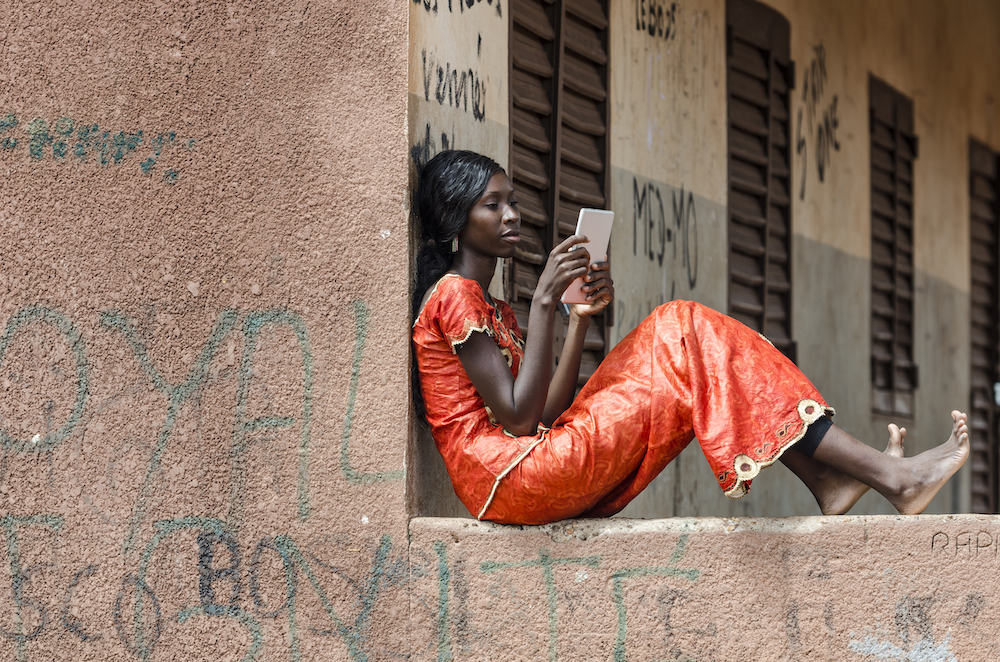FAQs
What else does My Digital World offer?
In addition to the six learning modules on the website, My Digital World also provides guides for educators on best practices for teaching students in both an online and offline setting and provides resources for parents and guardians to use at home to reiterate the lessons taught in the classroom.
Who are these lessons meant for and how were they created?
The lessons are designed for students aged 13-18 years old in Sub-Saharan Africa. The curriculum is designed with step-by-step instructions for teachers of students in this age range. These lessons are drawn from the resources of several expert partners with experience designing content and curriculum. Please see the About Us page on the website to learn more about our content partners.
What does a lesson look like?
Each lesson is fully scripted but provides room for facilitators to adapt the content to fit the needs of learners and their learning environments. The lessons serve both high-tech and low-tech communities — many of the lessons have been developed for learning settings with little to no internet access.
FAQs
What else does My Digital World offer?
In addition to the six learning modules on the website, My Digital World also provides guides for educators on best practices for teaching students in both an online and offline setting and provides resources for parents and guardians to use at home to reiterate the lessons taught in the classroom.
Who are these lessons meant for and how were they created?
The lessons are designed for students aged 13-18 years old in Sub-Saharan Africa. The curriculum is designed with step-by-step instructions for teachers of students in this age range. These lessons are drawn from the resources of several expert partners with experience designing content and curriculum. Please see the About Us page on the website to learn more about our content partners.
What does a lesson look like?
Each lesson is fully scripted but provides room for facilitators to adapt the content to fit the needs of learners and their learning environments. The lessons serve both high-tech and low-tech communities — many of the lessons have been developed for learning settings with little to no internet access.
Glossary
Access Point
An access point is anything that transmits (broadcasts) a Wi-Fi signal and provides access to the internet.
Artificial Intelligence (AI)
The ability to understand the algorithms involved in the AI-based platforms one interacts with and the ethical conversations happening around the development of these technologies.
Civic and Political Engagement
The ability to participate in public matters (e.g., LGBTQ rights, peace building, addressing hate speech) and advocate for issues one cares about — using digital and non-digital tools — ideally to promote the quality of life in one’s community from micro to macro levels (Levine, 2007).
Computational Thinking
The ability to understand and apply computational concepts, practices, and perspectives. Computational concepts include concepts individuals leverage as they program (e.g., “sequencing” or identifying a set of steps for a task, “loops” or running the same series of steps multiple times). Computational practices represent the practices individuals cultivate while they program (e.g., “experimenting and iterating,” “reusing and remixing,” or creating something by building upon current ideas or projects). Finally, computational perspectives refer to the perspectives individuals develop about themselves, their connections to others (such as within the context of collaborative online communities) and the technological world more broadly (e.g., “connecting” or understanding the power of developing content both with and for others) (Brennan & Resnick, 2012).
Content Production
The ability to produce (digital) content using (digital) tools.
Context
The ability to be aware of, understand, and interpret the contextual factors of relevance (e.g., cultural, social, local/regional/global) in a given situation — with a particular emphasis on the experiences and perspectives of underrepresented groups, whether in terms of age, ethnicity, race, gender and sexual identity, religion, national origin, location, skill and educational level, and/or socioeconomic status — and effectively engage in the situation.
Data
The ability to be aware of, create, collect, represent, evaluate, interpret, and analyze data from digital and non-digital sources.
Digital Access
The ability to connect to and access the internet, individually or collectively (e.g., mesh technologies).
Digital Economy
The ability to navigate economic activities online and offline to earn different forms of economic, social, and/or cultural capital (e.g., earning money, increasing social connections, building personal brands).
Digital Literacy
The ability to use the internet and other digital tools and platforms effectively to find, interact with, evaluate, create, and reuse information (Palfrey & Gasser, 2016). The ability to comprehend and work through conceptual problems in digital spaces (Carretero, Vuorikari & Punie, 2017).
Identity Exploration and Formation
The ability to use (digital) tools to explore elements of one’s own identity and to understand how communities are part of shaping one’s identity.
Information Quality
The ability to find, interact with, evaluate, create, and reuse information (broadly speaking; e.g., news, health information, personal information) effectively (Palfrey & Gasser, 2016).
Internet
A vast computer network linking smaller computer networks worldwide. The internet includes commercial, educational, governmental, and other networks.
Law
The ability to engage with legal frameworks, concepts, and theories surrounding the internet and other digital tools (e.g., copyright, fair use) and the ability to apply these frameworks to one’s activities.
Media Literacy
The ability to analyze, evaluate, circulate, and create content in any media form (e.g., print, visual, interactive, audio) and to participate in communities and networks. “Media literacies,” in plural, include “media literacy” (Hobbs, 2010), what some researchers have conceptualized as “new literacies” (Lankshear & Knobel, 2007), and “new media literacies” (Jenkins, Clinton, Purushotma, Robison & Weigel, 2006). That is, they encompass not only literacy approaches that focus on individual engagement with media (media literacy) but also competencies that address community involvement and participatory cultures. “Media literacies” also include literacies such as reading and writing.
Modem
A modem is a device that creates and maintains a connection to your Internet Service Provider (ISP) to give you access to the internet. It converts signals from outside your given location into signals that can be read by your computer and other digital devices.
Network
A network is a collection of computer systems and devices that are linked together worldwide.
Positive/Respectful Behavior
The ability to interact with others (both individuals and the larger collective) online in a respectful, ethical, socially responsible, and empathetic manner.
Privacy and Reputation
The ability to protect one’s personal information online and that of others. An understanding of the digital “trail” left behind as a result of the activities one engages in online, the short- and long-term consequences of this trail, the appropriate management of one’s virtual footprint, as well as an understanding of inferred data (i.e., new data derived from capturing and analyzing other data points, which may result in new knowledge about a person (van der Hof, 2016)).
Router
A router is a device that creates a network between all the devices (e.g. computers, tablets, mobile phones) in a given location (like a school, library, or your home).
Safety and Well-Being
The ability to counteract the risks that the digital world may come with to protect one’s physical and mental well-being (e.g., guarding against internet addiction and repetitive stress syndrome). Online risks can be classified along three main dimensions: conduct (e.g., cyberbullying, sexual harassment, or unwelcome “sexting”), contact (e.g., face-to-face meeting after online contact, communication with individuals pretending to be another person), and content (e.g., exposure to pornographic content, violent or aggressive content, harmful speech, content about drugs, racist content) (Livingstone, Kirwall, Ponte & Staksrud, 2013).
Security
The ability to protect the integrity of one’s information, digital devices, and assets (e.g., login information such as passwords, profiles, and websites).
Glossary
Access Point
An access point is anything that transmits (broadcasts) a Wi-Fi signal and provides access to the internet.
Artificial Intelligence (AI)
The ability to understand the algorithms involved in the AI-based platforms one interacts with and the ethical conversations happening around the development of these technologies.
Civic and Political Engagement
The ability to participate in public matters (e.g., LGBTQ rights, peace building, addressing hate speech) and advocate for issues one cares about — using digital and non-digital tools — ideally to promote the quality of life in one’s community from micro to macro levels (Levine, 2007).
Computational Thinking
The ability to understand and apply computational concepts, practices, and perspectives. Computational concepts include concepts individuals leverage as they program (e.g., “sequencing” or identifying a set of steps for a task, “loops” or running the same series of steps multiple times). Computational practices represent the practices individuals cultivate while they program (e.g., “experimenting and iterating,” “reusing and remixing,” or creating something by building upon current ideas or projects). Finally, computational perspectives refer to the perspectives individuals develop about themselves, their connections to others (such as within the context of collaborative online communities) and the technological world more broadly (e.g., “connecting” or understanding the power of developing content both with and for others) (Brennan & Resnick, 2012).
Content Production
The ability to produce (digital) content using (digital) tools.
Context
The ability to be aware of, understand, and interpret the contextual factors of relevance (e.g., cultural, social, local/regional/global) in a given situation — with a particular emphasis on the experiences and perspectives of underrepresented groups, whether in terms of age, ethnicity, race, gender and sexual identity, religion, national origin, location, skill and educational level, and/or socioeconomic status — and effectively engage in the situation.
Data
The ability to be aware of, create, collect, represent, evaluate, interpret, and analyze data from digital and non-digital sources.
Digital Access
The ability to connect to and access the internet, individually or collectively (e.g., mesh technologies).
Digital Economy
The ability to navigate economic activities online and offline to earn different forms of economic, social, and/or cultural capital (e.g., earning money, increasing social connections, building personal brands).
Digital Literacy
The ability to use the internet and other digital tools and platforms effectively to find, interact with, evaluate, create, and reuse information (Palfrey & Gasser, 2016). The ability to comprehend and work through conceptual problems in digital spaces (Carretero, Vuorikari & Punie, 2017).
Identity Exploration and Formation
The ability to use (digital) tools to explore elements of one’s own identity and to understand how communities are part of shaping one’s identity.
Information Quality
The ability to find, interact with, evaluate, create, and reuse information (broadly speaking; e.g., news, health information, personal information) effectively (Palfrey & Gasser, 2016).
Internet
A vast computer network linking smaller computer networks worldwide. The internet includes commercial, educational, governmental, and other networks.
Law
The ability to engage with legal frameworks, concepts, and theories surrounding the internet and other digital tools (e.g., copyright, fair use) and the ability to apply these frameworks to one’s activities.
Media Literacy
The ability to analyze, evaluate, circulate, and create content in any media form (e.g., print, visual, interactive, audio) and to participate in communities and networks. “Media literacies,” in plural, include “media literacy” (Hobbs, 2010), what some researchers have conceptualized as “new literacies” (Lankshear & Knobel, 2007), and “new media literacies” (Jenkins, Clinton, Purushotma, Robison & Weigel, 2006). That is, they encompass not only literacy approaches that focus on individual engagement with media (media literacy) but also competencies that address community involvement and participatory cultures. “Media literacies” also include literacies such as reading and writing.
Modem
A modem is a device that creates and maintains a connection to your Internet Service Provider (ISP) to give you access to the internet. It converts signals from outside your given location into signals that can be read by your computer and other digital devices.
Network
A network is a collection of computer systems and devices that are linked together worldwide.
Positive/Respectful Behavior
The ability to interact with others (both individuals and the larger collective) online in a respectful, ethical, socially responsible, and empathetic manner.
Privacy and Reputation
The ability to protect one’s personal information online and that of others. An understanding of the digital “trail” left behind as a result of the activities one engages in online, the short- and long-term consequences of this trail, the appropriate management of one’s virtual footprint, as well as an understanding of inferred data (i.e., new data derived from capturing and analyzing other data points, which may result in new knowledge about a person (van der Hof, 2016)).
Router
A router is a device that creates a network between all the devices (e.g. computers, tablets, mobile phones) in a given location (like a school, library, or your home).
Safety and Well-Being
The ability to counteract the risks that the digital world may come with to protect one’s physical and mental well-being (e.g., guarding against internet addiction and repetitive stress syndrome). Online risks can be classified along three main dimensions: conduct (e.g., cyberbullying, sexual harassment, or unwelcome “sexting”), contact (e.g., face-to-face meeting after online contact, communication with individuals pretending to be another person), and content (e.g., exposure to pornographic content, violent or aggressive content, harmful speech, content about drugs, racist content) (Livingstone, Kirwall, Ponte & Staksrud, 2013).
Security
The ability to protect the integrity of one’s information, digital devices, and assets (e.g., login information such as passwords, profiles, and websites).
Featured

Passwords
Students will learn how to keep their online information more secure by using and maintaining strong passwords.
View Page
Connectivity
Students will learn to recognize unsecured Wi-Fi when it is available to them, understand the trade-offs inherent in using unsecured Wi-Fi, and make informed decisions about when to connect to and use unsecured Wi-Fi.
View Page
Cybersecurity, Phishing, and Spam
Students will learn about malicious online users who might attempt to use security weaknesses to gather information about them.
View Page
What is Verification?
Students will learn what information verification is and why it is important for news consumers.
View Page
The Verification Steps
Students will learn about a five-step checklist they can use to verify the origin, source, date, location, and motivation of news.
View Page
Passwords
Students will learn how to keep their online information more secure by using and maintaining strong passwords.
View Page
Connectivity
Students will learn to recognize unsecured Wi-Fi when it is available to them, understand the trade-offs inherent in using unsecured Wi-Fi, and make informed decisions about when to connect to and use unsecured Wi-Fi.
View Page
Cybersecurity, Phishing, and Spam
Students will learn about malicious online users who might attempt to use security weaknesses to gather information about them.
View Page
What is Verification?
Students will learn what information verification is and why it is important for news consumers.
View Page
The Verification Steps
Students will learn about a five-step checklist they can use to verify the origin, source, date, location, and motivation of news.
View Page